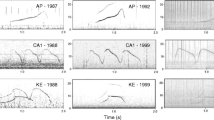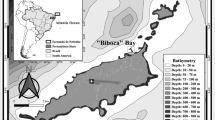Abstract
The signature whistle hypothesis states that dolphins produce highly stereotyped, individually distinctive whistles when in isolation. The presence of signature whistles has been called into question by recent studies proposing that dolphins produce a shared, simple upsweep whistle when in isolation, and that whistles produced by socializing dolphins are shared across individuals and social groups. This shared repertoire hypothesis suggests that when two animals produce the same whistle type, it is due to sharing the same common repertoire rather than one animal learning to produce the whistle of another. One difference between studies supporting or denying the existence of signature whistles is the method used to classify whistle types. We examined whistle production by 17 free-ranging bottlenose dolphins while temporarily restrained. We used both a quantitative comparison technique similar to that used to support the shared repertoire hypothesis and human judges to classify whistle types and quantify similarity between types. Contrary to recent studies that emphasize shared whistles, overall whistle sharing between isolated individuals was low (25%) and a simple upsweep did not account for the most common whistle type in half of the animals. Some species of birds, bats, and primates with stable social groups use vocal learning to converge over time to one common group distinctive call type. We examined whistle similarity between adult male dolphins that are partners in a close social alliance in order to test whether vocal learning may enable a similar vocal convergence. Whistle similarity was rated very high between partners and low between non-partners by both the quantitative technique and human observers. This suggests that as in songbirds and some other mammals, adult male bottlenose dolphins may use vocal learning to converge on similar whistles as they develop affiliative social relationships.




Similar content being viewed by others
References
Boughman JW (1997) Greater spear-nosed bats give group-distinctive calls. Behav Ecol Sociobiol 40:61–70
Boughman JW (1998) Vocal learning by greater spear-nosed bats. Proc R Soc Lond B 265:227–233
Boughman JW, Wilkinson GS (1998) Greater spear-nosed bats discriminate group mates by vocalizations. Anim Behav 55:1717–1732
Brown ED, Farabaugh SM, Veltman CJ (1988) Song sharing in a group-living songbird, the Australian magpie, Gymnorhina tibicen. Part I. Vocal sharing within and among social groups. Behaviour 104:1–28
Caldwell MC, Caldwell DK (1965) Individualized whistle contours in bottlenosed dolphins (Tursiops truncatus). Nature 207:434–435
Caldwell MC, Caldwell DK (1979) The whistle of the Atlantic bottlenosed dolphin (Tursiops truncatus)—ontogeny. In: Winn HE, Olla BL (eds) The behavior of marine animals. Plenum, New York, pp 369–401
Caldwell MC, Caldwell DK, Tyack PL (1990) Review of the signature-whistle hypothesis for the Atlantic bottlenose dolphin. In: Leatherwood S, Reeves RR (eds) The bottlenose dolphin. Academic, San Diego, pp 199–234
Connor RC, Smolker RA, Richards AF (1992) Dolphin alliances and coalitions. In: Harcourt AH, de Waal FBM (eds) Coalitions and alliances in humans and other animals. Oxford University Press, Oxford, pp 415–443
Dreher JJ, Evans WE (1964) Cetacean communication. In: Tavolga WN (ed) Marine bio-acoustics, vol 2. Pergamon, New York, pp 159–186
Duffield DA, Wells RS (2002) The molecular profile of a resident community of bottlenose dolphins, Tursiops truncatus. In: Pfeiffer CJ (ed) Molecular and cell biology of marine mammals. Krieger, Malabar, Fla., pp 3–11
Elowson AM, Snowdon CT (1994) Pygmy marmosets, Cebuella pygmaea, modify vocal structure in response to changed social environment. Anim Behav 47:1267–1277
Fripp DR (1999) Techniques for studying vocal learning in bottlenose dolphins, Tursiops truncatus. Ph.d Thesis, MIT/WHOI Joint Program, Woods Hole, Mass.
Herzing DL (1996) Vocalizations and associated underwater behavior of free-ranging Atlantic spotted dolphins, Stenella frontalis, and bottlenose dolphins, Tursiops truncatus. Aquat Mamm 22:61–79
Hohn AA, Scott MD, Wells RS, Sweeney JC, Irvine AB (1989) Growth layers in teeth from known-age, free-ranging bottlenose dolphins. Mar Mamm Sci 5:315–342
Janik VM (1999) Pitfalls in categorization of behaviour: a comparison of dolphin whistle classification methods. Anim Behav 57:133–143
Janik VM (2000) Whistle matching in wild bottlenose dolphins (Tursiops truncatus). Science 289:1355–1357
Janik VM, Slater PJB (1998) Context-specific use suggests that bottlenose dolphin signature whistles are cohesion calls. Anim Behav 56:829–838
Janik VM, Denhardt G, Todt D (1994) Signature whistle variations in a bottlenosed dolphin, Tursiops truncatus. Behav Ecol Sociobiol 35:243–248
Mammen DL, Nowicki S (1981) Individual differences and within-flock convergence in chickadee calls. Behav Ecol Sociobiol 9:179–186
McCowan B (1995) A new quantitative technique for categorizing whistles using simulated signals and whistles from captive bottlenose dolphins (Delphinidae, Tursiops truncatus). Ethology 100:177–193
McCowan B, Reiss D (1995) Quantitative comparison of whistle repertoires from captive adult bottlenose dolphins (Delphinidae, Tursiops truncatus): a re-evaluation of the signature whistle hypothesis. Ethology 100:194–209
McCowan B, Reiss D (2001) The fallacy of ‘signature whistles’ in bottlenose dolphins: a comparative perspective of ‘signature information’ in animal vocalizations. Anim Behav 62:1151–1162
Miksis JL, Tyack PL, Buck JR (2002) Captive dolphins, Tursiops truncatus, develop signature whistles that match acoustic features of human-made model sounds. J Acoust Soc Am 112:728–739
Owen ECG, Wells RS, Hofmann S (2002) Ranging and association patterns of paired and unpaired adult male bottlenose dolphins, Tursiops truncatus, in Sarasota, Florida provide no evidence for alternative male strategies. Can J Zool 80:2072–2089
Podos J, Peters S, Rudnicky T, Marler P, Nowicki S (1992) The organization of song repertoires in song sparrows: themes and variations. Ethology 90:89–106
Reiss D, McCowan B (1993) Spontaneous vocal mimicry and production by bottlenose dolphins (Tursiops truncatus): evidence for vocal learning. J Comp Psychol 107:301–312
Richards DG, Wolz JP, Herman LM (1984) Vocal mimicry of computer-generated sounds and vocal labeling of objects by a bottlenosed dolphin Tursiops truncatus. J Comp Psychol 98:10–28
Ridgway SH, Carder DA, Kamolnick T, Smith RR, Schlundt CE, Elsberry WR (2001) Hearing and whistling in the deep sea: depth influences whistle spectra but does not attenuate hearing by white whales (Delphinapterus leucas) (Odontoceti, Cetacea). J Exp Biol 204:3829–3841
Sayigh LS, Tyack PL, Wells RS, Scott MD (1990) Signature whistles of free-ranging bottlenose dolphins Tursiops truncatus: stability and mother–offspring comparisons. Behav Ecol Sociobiol 26:247–260
Sayigh LS, Tyack PL, Wells RS, Scott MD, Irvine AB (1995) Sex differences in signature whistle production in free-ranging bottlenose dolphins. Behav Ecol Sociobiol 36:171–177
Smolker RA, Pepper JW (1999) Whistle convergence among allied male bottlenose dolphins (Delphinidae, Tursiops sp). Ethology 105:595–617
Trainer JM, McDonald DB (1995) Singing performance, frequency matching, and courtship success of long-tailed manakins (Chiroxiphia linearis). Behav Ecol Sociobiol 37:249–254
Tyack PL (1986) Whistle repertoires of two bottlenose dolphins, Tursiops truncatus: mimicry of signature whistles? Behav Ecol Sociobiol 18:251–257
Tyack PL, Sayigh LS (1997) Vocal learning in cetaceans. In: Snowdon CT, Hausberger M (eds) Social influences on vocal development. Cambridge University Press, Cambridge, Mass., pp 208–233
Wells RS (1991) The role of long-term study in understanding the social structure of a bottlenose dolphin community. In: Pryor K, Norris KS (eds) Dolphin societies: discoveries and puzzles. University of California Press, Berkeley, Calif., pp 199–225
Wells RS, Irvine AB, Scott MD (1980) The social ecology of inshore odontocetes. In: Herman LM (ed) Cetacean behavior: mechanisms and functions. Wiley, New York, pp 263–317
Wells RS, Scott MD, Irvine AB (1987) The social structure of free-ranging bottlenose dolphins. In: Genoways H (ed) Current mammalogy, vol 1. Plenum, New York, pp 247–305
Acknowledgements
We are extremely grateful to Laela Sayigh and her students for the majority of the data collection of the whistles used in this study. We very much appreciate the efforts of Michael Scott and Blair Irvine, as well as a dedicated group of staff and volunteers, to ensure safe and effective handling of the dolphins for collection of the whistle recordings over the years. Aleta Hohn provided age data for individuals for which ages were not determined from observations during birth years. We would like to thank Nancy Dimarzio, Sarah Marsh, Jennifer Miksis, Patrick Miller, Susan Parks, and Rebecca Thomas for performing the similarity comparisons. Deborah Fripp provided assistance with digitization and cluster analysis and Stephanie Nowacek and Edward Owen calculated male pair association data. Three anonymous reviewers, Lars Bejder, and Suzanne Yin greatly improved this manuscript. Funding for the sound data collection, health assessment, and survey/observation program was provided by the Earthwatch Institute, National Marine Fisheries Service, Chicago Zoological Society, Dolphin Quest, NSF, EPA, Ocean Ventures Fund, ONR, and NIH. S.L. Watwood was funded by an NSF Coastal Processes Traineeship, NSF Grant No. SN-9975523, and Woods Hole Oceanographic Institution Academic Programs Department. Data were collected under NMFS scientific permits issued to R. Wells. This is contribution no. 10799 of the Woods Hole Oceanographic Institution.
Author information
Authors and Affiliations
Corresponding author
Additional information
Communicated by G. Wilkinson
Rights and permissions
About this article
Cite this article
Watwood, S.L., Tyack, P.L. & Wells, R.S. Whistle sharing in paired male bottlenose dolphins, Tursiops truncatus . Behav Ecol Sociobiol 55, 531–543 (2004). https://doi.org/10.1007/s00265-003-0724-y
Received:
Revised:
Accepted:
Published:
Issue Date:
DOI: https://doi.org/10.1007/s00265-003-0724-y




